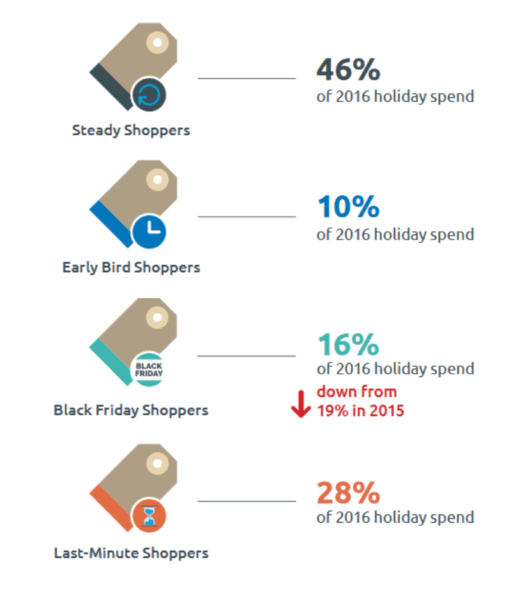2017 holiday shopping trends: How consumers plan to research & purchase gifts this season
- Fahad H

- Nov 10, 2017
- 3 min read

Two weeks out from the busiest holiday shopping time of the year, many holiday shoppers are already hitting the buy button.
Cardlytics, a company that provides an online rewards platform for financial institutions, says that 40 percent of holiday spend happens in the four weeks leading up to Black Friday, and that last year’s Black Friday results accounted for 16 percent of the total holiday spend.
Using its proprietary platform, the firm analyzed year-over-year holiday spend between 2015 and 2016 to identify trends for its “2017 Holiday Spend: Retail Purchase Insights” report.
As part of their research, Cardlytics broke down holiday shoppers into separate segments defined by when they shop. According to their findings, the largest majority of holiday shoppers are the people who shop all season long.
“There are four distinct holiday shopper timing segments, running three weeks each,” says Cardlytics, “Each segment contributes to the overall holiday spend.”
Cardlytics: Four distinct shopper timing segments

Sociomantic Labs, a programmatic ad solution, conducted similar holiday research and found retailers experienced a 23 percent year-over-year lift in sales during the week leading up to last year’s Black Friday-Cyber Monday time period.
Looking toward this year’s holiday shopping season, digital marketing platform, VigLink conducted a survey of 500 consumers to determine their holiday shopping preferences.
The largest majority of Viglinks survey respondents — 40 percent — said they will start shopping for the holidays in November. The percentage of people who said they start in October was a near even split with those who said they start in December (19.4 percent versus 20.2 percent).
When VigLink asked survey participants where they are most likely to gather information about holiday purchases, the top three resources were friends (58 percent), reviews on a company’s website (46 percent) and reviews from third-party sources, such as blogs, forums and so on (38 percent).
Thirty-two percent said they turn to social media to find information about holiday gift purchases.
As far as the content consumers want when researching holiday purchases, 70 percent said “customer reviews” when asked to name the types of information “most helpful” for making a purchase decision, while 57 percent said pricing information (including coupons and discounts), and 50 percent listed product specifications.
Valassis, a campaign management platform, also surveyed consumers, polling specifically 500 Cyber Monday shoppers, to determine their preshopping routines. Referring to the day preceding Cyber Monday as “Sofa Sunday,” Valassis wanted to find out how shoppers would prepare for the online holiday shopping day.
According to its findings, 45 percent of shoppers will spend two hours or more at home researching Cyber Monday deals. Of the survey participants who plan to do research at home on “Sofa Sunday,” 52 percent will look for bargains from their desktop or laptop and 36 percent will do their research on a mobile phone.
Valassis says nearly two-thirds (63 percent) of Cyber Monday shoppers who are doing research both at home and on-the-go will be using their mobile phones.
Last week, Adobe released a report forecasting online holiday sales to reach $107.4 billion. According to Adobe’s data, this year’s Cyber Monday will be the largest online shopping day in history — generating $6.6 billion in sales (up 16.5 percent over last year’s earnings).
Also, as we reported last month, Deloitte predicts big gains as well this holiday season for online retailers, forecasting an 18 to 21 percent increase over last year’s results, with e-commerce outperforming in-store purchases.
“Brands and retailers that develop their holiday media strategies with the full consumer decision journey in mind are more likely to reach shoppers with relevant, timely messages,” says Valassis CMO Curtis Tingle, “and ultimately secure a bigger piece of the retail pie during this critical shopping season.”








Comments